MUMBAI / BOMBAY, Capital of Maharashtra, is the fastest moving city of India. Mumbai, being the commercial capital of the country, it is a land for finance, trade and entertainment of the country. This city is full of excitement energy and enthusiasm. The city displays a cosmopolitan character which reflects in its cuisine, culture, inhabitants and language.
The bustling city, is the most busy ports of India and handles about 40 percent of India's Martine trade. The city which is a part of India's splendid coast, has a natural harbour developed by the British.
The city which was earlier the land of Kolis, came under the Portuguese rule in 1534. Mumbai derives its name from Mumba Devi whose temple still exists here. The Portuguese however named it 'Bom Baim" meaning good bay. Mumbai earlier was made of seven islands which are today called Colaba, Mahim, Mazgaon, Parel, Worli, Girgaum and Dongri. The profit hungry Britishers transformed it into an excellent port and the large expanses of the open sea were filled in to further the land area. Nariman Point and Churchgate.
This fascinating city which houses people of all cultures and creeds, is throbbing with life and absorbing the ever increasing needs of the people there.
Places to visit
 |
| Gateway of India |
|
| Built in 1911 to commemorate the visit of George V to India, this is a principal landmark of Mumbai, situated at Colaba. This was officially inaugurated in 1924 to welcome the visitors who came to by ship. This distinctive monument was India's principal port. The monument's architecture reflects similarity with the conventional arch of Triumph. Colaba Causeway extending to one end of Colaba promontory, southern end of Mumbai Island is situated near Gateway of India. One more interesting place here is the Sassoon dock, especially when the fishing boats come in and unload their catch. The gorgeous Hotel Taj Mahal also lies in Colaba. |
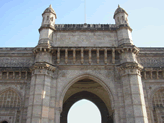 |
 |
| Flora Fountain |
|
| The Flora Fountain erected in 1869 in honour of Sir Bartle Frere (Governor of Mumbai in 1862-67), now bustles with busy life and is the many business centre housing many major banks and offices. Gerald Aungier began the Cathedral of St. Thomas in 1672, which was formally opened in 1718 to the fountain.
Running along the shoreline of Backbay, extending from Nariman Point around by Chowpatty beach upto Malabar Hills, is the most popular strolling pavement of Mumbai, built on land reclaimed during 1920. One of the most popular spots for evening outs is Chowpatty beach which also is famous for its junk food. The lively atmosphere during Ganesh Chaturthi Festival is worth a visit. One of the most fascinating landmark of Mumbai is the VT or Victoria Terminus designed by F.W. Stevens in Italian Gothic. In 1853 the first train ran from here to Thane. |
 |
 |
| Marine Drive |
|
| On Marine Drive also lies the Taraporewala Aquarium which houses fresh water as well as saltwater fishes. A fantastic view of Mumbai can be seen from the Hanging Gardens and Kamala Nehru Park, set on the top of Malabar. The famous Mahalaxmi Temple, is the oldest temple in Mumbai, dedicated to the Goddess of Wealth which lies some distance away from Malabar Hills. A little further away is a long causeway which leads to Haji Ali tomb and mosque, accessible during low tide. In Prabhadevi comes the exquisite temple of Siddhivinayak dedicated to Lord Ganesha always bustling with devotees. Juhu Beach, Nehru Planetarium and Nehru Science Centre are other tourist attractions. |
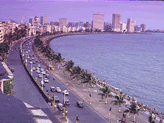 |
 |
| Chowpatty Beach |
|
| Mumbai's famous beach is no place for a sun bathe or a dip. In fact, there's not much going on at Chowpatty at all during the day, but in the evening it develops a magical fairground atmosphere as locals come to stroll among the contortionists, masseurs, transvestites, balloon sellers, gamblers, fortune tellers, magicians, drug dealers, nut vendors, ferris wheels and shooting galleries. In the middle of all this mayhem is a small Koli fishing community, where the original inhabitants of the island mend their nets and dry their fish oblivious to the shenanigans going on around them. Eating at the collection of stalls on the edge of the beach is an essential part of the Mumbai experience. Chowpatty is a great place to witness the annual Ganesh Chaturthi Festival in August / September when large images of the elephant-headed god are immersed in the murky sea. |
 |
 |
| Elephanta Caves |
|
| Mumbai's major tourist attractions are the rock-cut temples on peaceful Elephanta Island, 10km ( 6miles ) north-east of the Gateway of India. Thought to have been carved between 450 and 750 AD, the temples survived Portuguese vandalism (one cave was reputedly used by a Portuguese battalion as a shooting gallery) and remain equal in size, beauty and power to the caves at Ajanta and Ellora. The main cave contains large sculpted panels relating to Siva, including the astonishing 6mt ( 20 feet ) high triple-headed Trimurti - in which Siva embodies the roles of creator, preserver and destroyer. Boats run daily from Mumbai's Apollo Bunder every hour until early afternoon, although it's best to make the trip during the week. |
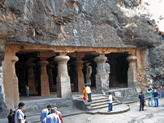 |
 |
| Haji Ali Mosque |
|
| Situated at the end of a long causeway poking into the Arabian Sea, is a whitewashed fairytale mosque containing the tomb of the Muslim Saint Haji Ali. The saint is believed to have been a wealthy local businessman who renounced the material world and meditated on a nearby headland following a pilgrimage to Mecca. The mosque and tomb were built by devotees in the early 19th century. Alternative versions say Haji Ali died while on a pilgrimage to Mecca and his casket amazingly floated back to Bombay and landed at this spot. The mosque can only be reached at low tide, when the causeway is lined with beggars suffering every imaginable affliction and deformity . There's nothing somber about the building's cool courtyard, which is generally full of chattering families and refreshment stalls. The rocks exposed at low tide behind the mosque are a favourite spot to catch sea breezes. |
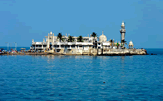 |
 |
| Chor Bazar |
|
| No visit to Mumbai is complete without a foray into the bazaars of Kalbadevi, north of Crawford Market. The narrow lanes of this predominantly Muslim area are hemmed in by laundry-draped chawls , and a seething mass of people bring Mumbai's traffic to a standstill. It's in complete contrast to the relative space, orderliness and modernity of South Mumbai. Entire streets are often devoted to a single product since caste traditions remain stronger than capitalist marketing theories; this can make browsing a strange experience as you suddenly encounter shop after shop selling bathroom fittings or copper pipes. Some people consider the bazaars a spectacle rather than a place to shop, but it's a lot more fun doing both. The main areas are Zaveri Bazaar (jewellery), Mangaldas Market (cloth), Dhabu Street (leather goods) and Chor Bazaar (Mumbai's `thieves' market'). You can pick up anything at Chor Bazaar from car parts to Victorian porcelain - the traditional joke is that it was probably stolen from you in the first place. Mutton St in Chor Bazaar specialises in antiques, ingenious reproductions and miscellaneous junk. Don't place too much faith in authenticity or the lifespan of objects with mechanical parts. |
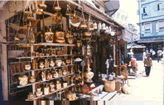 |
|
|



